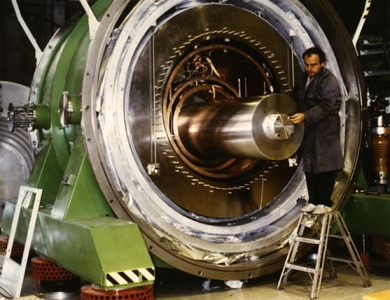Astrophysik: Gravitationsdetektoren
Detecting gravitational waves

One kind of gravitational wave detector, the so-called resonant detectors, are designed to measure the influence of a gravitational wave on a massive object such as a metal cylinder. The stretching and shrinking of space by which the gravitational wave shows its presence should induce oscillations of such a cylinder; measuring these oscillations would be a way to detect the gravitational waves. This method was first used by the pioneer of gravitational wave research Joseph Weber (1919-2000) in the 1960s. Todays resonant detectors cool the test mass down to a temperature close to absolute zero, in order to minimize certain types of noise. The image shows the Italian detector Nautilus, opened up to reveal the cylindrical test mass inside; around it, one can see the thermal insulation and vacuum tank.
[ Sitemap ]
[ info ] This website was created by the MPI for the History of Science.
 Scene
Scene


 1st Slide
1st Slide
 Branching Point
Branching Point
 Module: Astrophysik: Gravitationsdetektoren
Module: Astrophysik: Gravitationsdetektoren Sequence: Gravitationswellendetektoren Einstieg
Sequence: Gravitationswellendetektoren Einstieg Branching Point: Gravitational wave detectors
Branching Point: Gravitational wave detectors Slide: Detecting gravitational waves
Slide: Detecting gravitational waves
